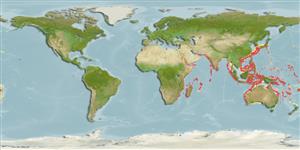Environment: milieu / climate zone / depth range / distribution range
Ecología
marino batidemersal; rango de profundidad 100 - 500 m (Ref. 11897). Deep-water
Indian Ocean: from the Andaman Sea and may extend nearby (i.e. India).
Tamaño / Peso / Age
Maturity: Lm ? range ? - ? cm
Max length : 10.0 cm TL macho / no sexado; (Ref. 6612)
Short description
Claves de identificación | Morfología | Morfometría
Radios blandos dorsales (total) : 5; Espinas anales: 0; Radios blandos anales: 4. This species is characterized by the following: subopercular buckler dull, with many small blunt spinelets at its tip; the ventral surface is covered with small- to mid-bucklers, totally naked between these bucklers; relatively short and blunt rostrum, directed upward; principal bucklers on dorsal surface relatively small and low; dorsal surface with few brown rings (Ref. 86633).
A benthic species (Ref. 75154) found on the continental slope (Ref. 7300, 75154).
Life cycle and mating behavior
Maturities | Reproducción | Spawnings | Egg(s) | Fecundities | Larva
Paxton, J.R., D.F. Hoese, G.R. Allen and J.E. Hanley, 1989. Pisces. Petromyzontidae to Carangidae. Zoological Catalogue of Australia, Vol. 7. Australian Government Publishing Service, Canberra, 665 p. (Ref. 7300)
IUCN Red List Status (Ref. 130435)
Threat to humans
Harmless
Human uses
Herramientas
Special reports
Download XML
Fuentes de Internet
Estimates based on models
Preferred temperature (Ref.
123201): 11.8 - 22.9, mean 15.9 °C (based on 294 cells).
Phylogenetic diversity index (Ref.
82804): PD
50 = 0.5001 [Uniqueness, from 0.5 = low to 2.0 = high].
Bayesian length-weight: a=0.01000 (0.00244 - 0.04107), b=3.04 (2.81 - 3.27), in cm total length, based on all LWR estimates for this body shape (Ref.
93245).
Nivel trófico (Ref.
69278): 3.3 ±0.5 se; based on size and trophs of closest relatives
Resiliencia (Ref.
120179): Medio, población duplicada en un tiempo mínimo de 1.4-4.4 años (Preliminary K or Fecundity.).
Fishing Vulnerability (Ref.
59153): Low vulnerability (10 of 100).
